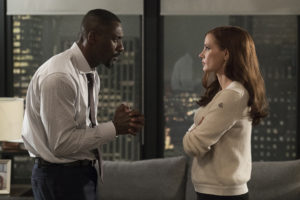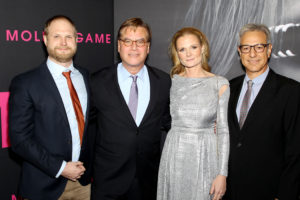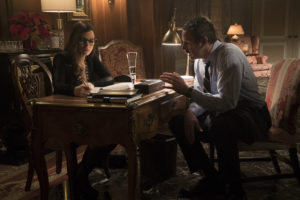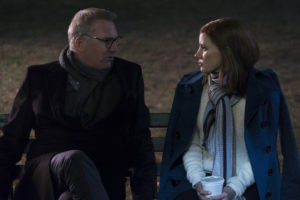
One of the finest elements about Aaron Sorkin’s directorial debut in Molly’s Game is the editing and how it is beautifully woven and interlaced together as it naturally flows with elegance and aura. The editing process is exceptionally powerful in shaping every movie. To achieve this level of grandeur, not one, not two, but three talented editors uniformly contributed being Alan Baumgarten (Joy, American Hustle), Josh Schaeffer (Kong: Skull Island, Pacific Rim Uprising), and Elliot Graham (Steve Jobs, Superman Returns).
The multiple editors began with Elliot Graham, the 3rd editor, but unfortunately was on limited availability, in turn he brought on Josh Schaeffer as they previously worked together having similar sensibilities. After Graham’s departure, Alan Baumgarten joined the team. The film had two editors at any given moment. The movie was divided into sequences, not scenes, but more like ideas. Sorkin gave the editors copious free reign to experiment with alternate ideas in regards to the dialogue and was extremely open to ideas, comments, and the challenging of his own script.
Voiceover was an integral component for this particular film.

“Some voiceover in the script allows for a lot of experimentation in editing, because it was very important that the audience digested everything that was said, but simultaneously kept the rhythm and pacing of the dialogue. We say it’s like telling the story to a group of people, through an audience, somewhat casual but descriptive; telling it in a fun way, and letting people in on this story as the character is explaining. Jessica Chastain (Molly) just nailed it and gave it the right kind of tone, energy, and emotionality,” said Baumgarten.
The pacing is very much a stylistic play on the director’s vision. The editing followed the pace of each scene as they all had varying rhythms, but were all built on the performances. The audience is immediately thrust into the film’s targeted style through the pace, energy, and the use of many quick close-up shots in the opening scene.
The editors praised cinematographer Charlotte Bruus Christensen for much of the office scenes in New York as she provided the editors with a substantial amount of coverage, so they would have enough footage to keep it fresh.

“The challenge was asking the audience to understand the beats and making sure they were following. Similar challenges in every film are to care about the characters, understand what’s going on within tracking emotionally and being engaged. We had to creatively find things that worked for us and go through many durations of the right kind of content, but also the right style,” added Baumgarten.
This movie was not intended to be a movie about poker, rather a movie that acknowledged poker with intelligence and respect, but ultimately about Molly. The tension during the poker games was not about following the hands, but to understand the stakes of the game and know who to root for.
Schaeffer clarified, “Those scenes just had a built-in tension that we definitely tried to emphasize and let you feel like you were there watching the game, being part of it, and experiencing it.”

Molly’s Game captures the essence of a true story based on the events of Molly Bloom. The credit for this masterfully crafted film goes to the three editors, as their combined work is one of the premier elements that gives the movie sophistication with the contribution of a great script and outstanding performances. As all films start with the writing process, the editing is what ultimately transforms the words into magic on the screen.
Baumgarten and Schaeffer leave us with this. “Aaron clearly views editing as an extension of the writing process.”





